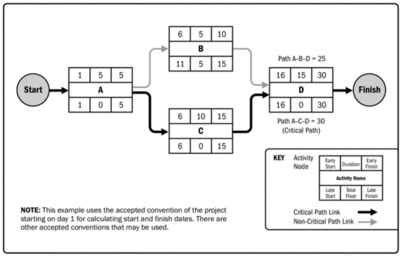Gantt chart and Scheduling techniques
Contents |
Abstract
Here you will write your draft for your wiki article, including at least 1 reference.
Scheduling
A plan can only show the practicability of accomplishing its objectives when the actions and activities in the plan, are put together in a schedule that illustrates when each action or activity will be carried out.
Today there is many different methods and approaches to scheduling. It can either be by computer-based planning tools or done manually [1].
Gantt chart
Definition
“A graphic display of schedule-related information. In the typical bar chart, schedule activities or work breakdown structure components are listed down the left side of the chart, dates are shown across the top, and activity durations are shown as date-placed horizontal bars.” [2]
How to create a Gantt chart?
| Checklist when creating a Gantt chart | |||||
|---|---|---|---|---|---|
| 1. 2. | |||||
Critical path method (CPM)
"A schedule network analysis technique used to determine the amount of scheduling flexibility (the amount of float) on various logical network paths in the project schedule network, and to determine the minimum total project duration. Early start and finish dates are calculated by means of a forward pass, using a specified start date. Late start and finish dates are calculated by means of a backward pass, starting from a specified completion date, which sometimes is the project early finish date determined during the forward pass calculation.” [3]
Constructing a Network Diagram
| Checklist when creating a Network Diagram | |||||
|---|---|---|---|---|---|
| 1. 2. | |||||
The connection
References
- ↑ Managing Successful Projects with PRINCE2. (2017). Managing Successful Projects With Prince2. The Stationery Office Ltd.
- ↑ Guide, A., 2001. Project management body of knowledge (pmbok® guide). In Project Management Institute. (p. 436)
- ↑ Guide, A., 2001. Project management body of knowledge (pmbok® guide). In Project Management Institute. (p. 431)
